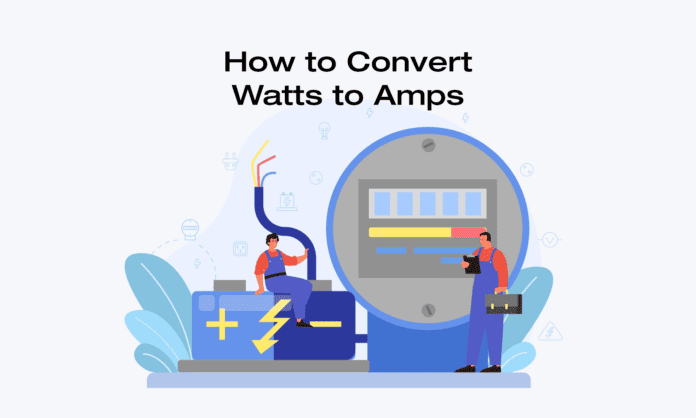Watts to Amps Calculator for DC Electricity
Watts to Amps Calculator for AC Electricity
Understanding Watts, Amps and Volts
Grasping the concepts behind watts, amps, and volts is vital to utilize electrical energy effectively. Whether you’re dealing with common household devices or advanced renewable systems, having a foundational understanding of these terms can be incredibly beneficial, if not necessary.
Watts
Watts represent the unit of power in the International System of Units (SI). Essentially, it quantifies the rate of energy transfer or conversion.
For instance, if a light bulb is rated at 60 watts, it means it uses 60 joules of energy per second when illuminated. In the context of electrical devices, watts measure how much electricity a device can deliver (output) or use (consume) per unit of time.
Amps
Amps, short for amperes, are the SI unit for electric current. They indicate the volume or flow rate of electrons passing through a circuit per second.
Think of it like water through a pipe: the larger the pipe (or higher the amp rating), the more water (or current) can flow through. In electrical systems, amps often give an idea of the capacity or limit of an electric device or circuit.
Volts
Volts measure electrical potential or voltage. In layman’s terms, you can view voltage as the “pressure” pushing the current through circuits.
A higher voltage often means more potential power, but it’s the combination of both volts and amps that determines the actual power output, quantified as watts. A common analogy is to think of volts as the water pressure in a hose, pushing water (current) through.
What Is AC/DC?
AC and DC refer to alternating current and direct current, respectively. AC is characterized by the continuous change in the direction of the current, typically in a sinusoidal manner, and is commonly used in residential power grids and most household outlets.
In contrast, DC maintains a constant direction, making it ideal for batteries and solar cells. Understanding the difference is crucial because the conversion of watts to amps may differ based on whether you’re working with AC or DC power.
How to Convert Watts to Amps for DC Power
The formula to convert watts to amps for DC electricity is straightforward.
Simply divide the power in watts by the voltage in volts, which gives you the current in amperes.
So, the formula for DC appliances can be expressed as:
Watts (W) / Volts (V) = Amps (A)
How to Convert Watts to Amps for AC Power
The vast majority of household appliances and consumer electronic devices run on AC electricity.
To convert watts to amps for AC power applications, you must consider the power factor (PF):
Watts (W) / (Power Factor (PF) x Volts (V)) = Amps (A)
What is the Power Factor in AC Electricity?
The power factor in AC electricity represents the difference between the actual power (watts) and the apparent power (volt-amperes).
When converting watts to amps with AC circuits, considering the power factor ensures a more accurate conversion.
Most consumer electrical appliances use purely inductive or capacitive circuits, which have a Power Factor of zero.
If a device’s primary function is to produce heat, it typically uses resistive circuitry.
For resistive circuits, the Power Factor is 1.
Keep in mind that heat is required for things you might not expect, like traditional lightbulbs.
Common examples of devices that typically (or always) use resistive circuitry include:
- Incandescent lights
- Toasters
- Hair dryers
- Space heater
Consult an electrician if you’re unsure whether your appliance uses inductive or resistive circuits.
Watts to Amps Table (120V)
| Power (W) | Voltage (V) | Current (A) |
| 10 watts | 120 volts | 0.0833 amps |
| 20 watts | 120 volts | 0.167 amps |
| 30 watts | 120 volts | 0.250 amps |
| 40 watts | 120 volts | 0.333 amps |
| 50 watts | 120 volts | 0.417 amps |
| 60 watts | 120 volts | 0.500 amps |
| 70 watts | 120 volts | 0.583 amps |
| 80 watts | 120 volts | 0.667 amps |
| 90 watts | 120 volts | 0.750 amps |
| 100 watts | 120 volts | 0.833 amps |
| 200 watts | 120 volts | 1.667 amps |
| 300 watts | 120 volts | 2.500 amps |
| 400 watts | 120 volts | 3.333 amps |
| 500 watts | 120 volts | 4.167 amps |
| 600 watts | 120 volts | 5.000 amps |
| 700 watts | 120 volts | 5.833 amps |
| 800 watts | 120 volts | 6.666 amps |
| 900 watts | 120 volts | 7.500 amps |
| 1000 watts | 120 volts | 8.333 amps |
Disclaimer: Calculators provided for educational use only with no guarantee of completeness, accuracy, timeliness or of the results obtained from the use of this information, and without warranty of any kind, express or implied, including, but not limited to warranties of performance, merchantability and fitness for a particular purpose. EcoFlow will not be liable to you or anyone else for any decision made or action taken in reliance on the information given by the calculator or for any consequential, special or similar damages, even if advised of the possibility of such damages.
